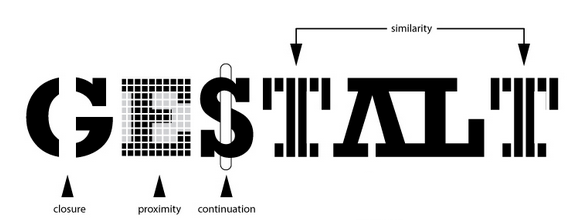Share this article:
It’s important to remember that great eLearning is a product of much more than graphics and content from SMEs or clients—it requires knowledge of how the adult mind learns and interprets information.
Psychology plays a major role in learning theory, and more specifically, Gestalt Theory is one pertinent topic that relates to eLearning.
Let’s look at the foundation of this theory and dive into how you can incorporate it into your next eLearning course.
What is Gestalt Theory?
Gestalt is the German word that means “shape of an entity’s complete form.” Introduced by Max Wertheimer, Kurt Koffka, and Wolfgang Kohler in 1922, this theory is often referenced in relation to human perception.
Basically, the foundation of this theory is that humans perceive every stimulus in its simplest, most basic form. Some refer to Gestalt Theory as The Law of Simplicity for this reason. Therefore, the theory focuses on grouping—because the whole is greater than the sum of its parts.
This theory tries to answer the question: “How does the mind make sense of a seemingly chaotic world?”
Laws of Organization
Working from the principle that the human mind is holistic and self-organizing, the theory includes the 4 Laws of Organization, which are:
- Proximity: Items are grouped based on their immediacy
- Similarity: Similar items tend to be grouped together
- Closure: Grouping occurs if they are part of a larger entity
- Simplicity: Items should be organized into simple figures based on attributes
While originally used in reference to visual representations, these principles help us create learning that makes it easy for the brain to view concepts as a whole and as their individual parts.
Think of it like this: When you’re teaching a team the basics of a sales call, you want them to learn all of the individual steps that contribute to the overall outcome of a sale, right? Using Gestalt Theory in your eLearning, you can break down each step of that process so that the learner can see each part of the process as part of the larger outcome.
Other Lessons from Gestalt Theory
Looking at your eLearning course through the principles of Gestalt Theory, it becomes easier to recognize gaps and incongruences in processes that lead to errors in training. For every process that you teach, you should be able to see not only every detailed step, but also how those steps result in the final positive outcome.
However, missing steps in a process can also be leveraged as a teaching moment. Letting learners find the missing pieces of a larger strategy helps make sure they know how a process works piece by piece.
Final Lesson
It can be tempting to teach at a macro level rather than diving down into the details with eLearning, but this theory reminds us to elaborate on the fundamental pieces of processes and lessons for greater understanding.

About
Tim Buteyn
Tim Buteyn, President of ThinkingKap Learning Solutions, has been in the training and instructional design field for almost 20 years. He founded the company because of his passion for creating engaging learning experiences. Adult learning theory, instructional design, innovative instructional strategies, and accelerated learning concepts have driven him to create ThinkingKap Learning Solutions.
